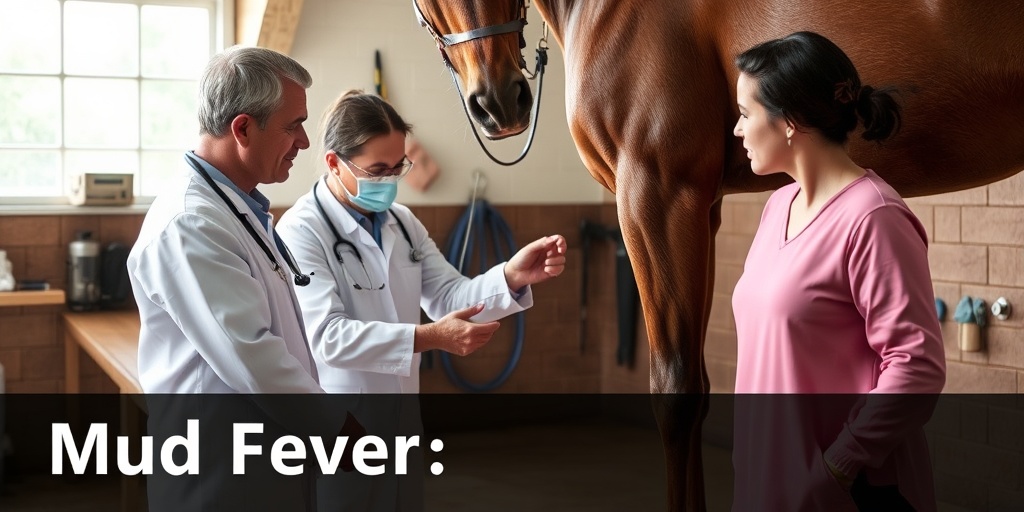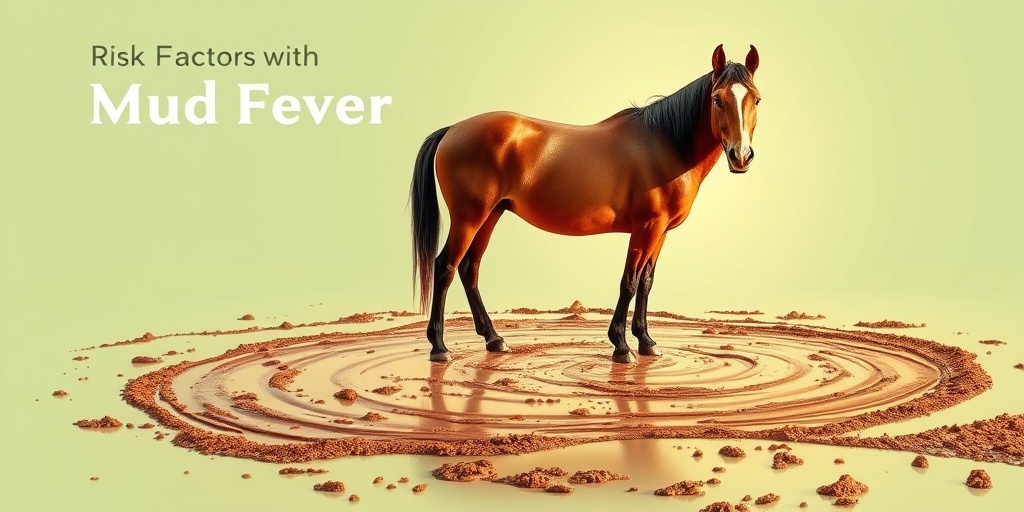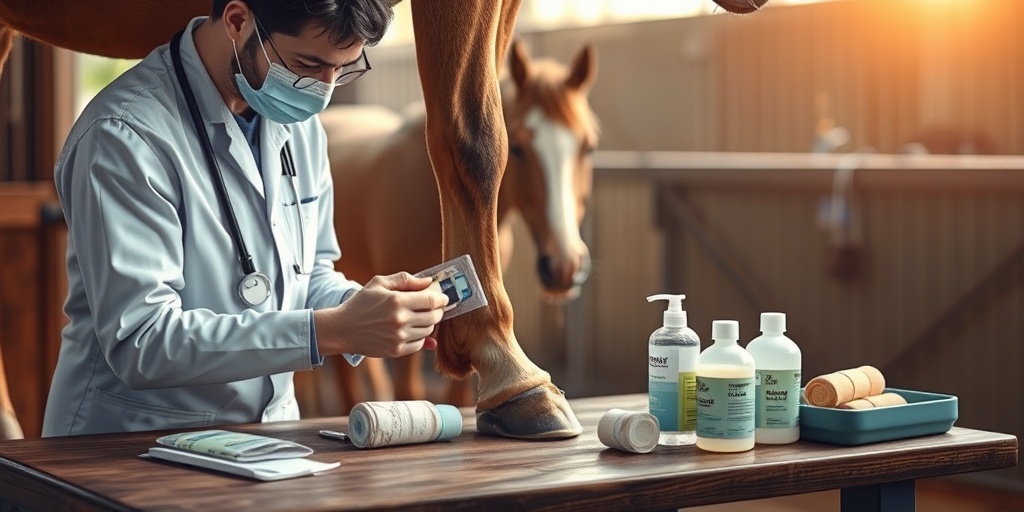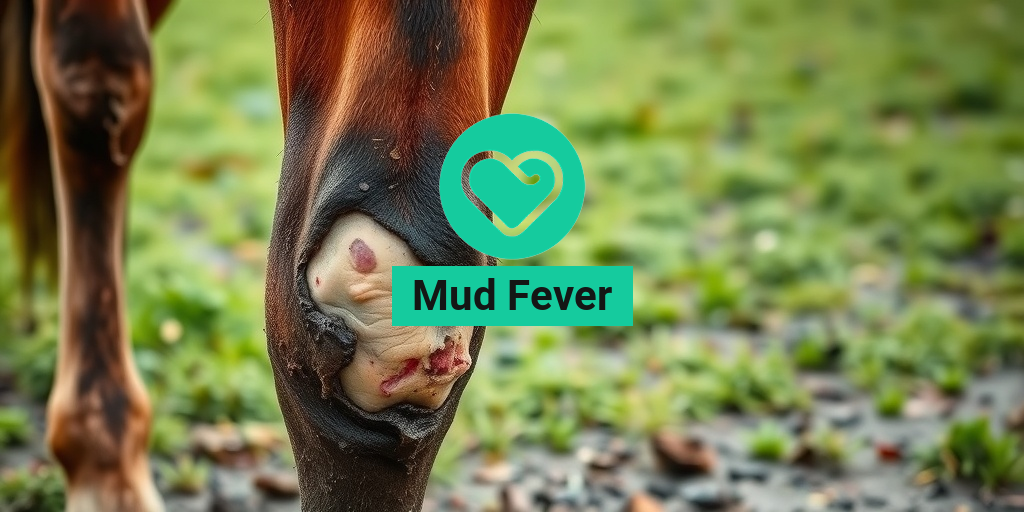What Is Mud Fever?
Mud fever, also known as scratches or pastern dermatitis, is a common skin condition that primarily affects horses, particularly during wet and muddy conditions. This condition is characterized by inflammation and irritation of the skin, usually found on the lower legs and pasterns. While it is most prevalent in horses, it can also occur in humans, particularly in those who frequently come into contact with wet and muddy environments.
The underlying cause of mud fever is often linked to a combination of factors, including moisture, bacteria, and skin sensitivity. When horses stand in muddy or wet conditions for extended periods, their skin can become compromised, allowing bacteria to penetrate and cause infection. This is why mud fever is particularly common in rainy seasons or in areas with poor drainage.
Who Is at Risk?
While any horse can develop mud fever, certain breeds and conditions may increase the risk. Horses with long feathers on their legs, such as Clydesdales or Shires, are more susceptible due to the moisture retention in their coat. Additionally, horses with compromised immune systems or those that have previously suffered from skin conditions are at a higher risk.
Why Is It Important to Address Mud Fever?
Ignoring mud fever can lead to more severe complications, including chronic skin infections and discomfort for the horse. Early intervention is crucial to prevent the condition from worsening. If you suspect your horse has mud fever, it’s essential to consult with a veterinarian for proper diagnosis and treatment.
Mud Fever Symptoms
Recognizing the symptoms of mud fever early can make a significant difference in treatment outcomes. Here are some common signs to look out for:
- Swelling: The affected area may appear swollen and inflamed.
- Redness: The skin may become red and irritated.
- Crusting: You might notice crusty scabs or lesions on the skin.
- Itching: Horses may exhibit signs of discomfort, such as itching or rubbing their legs.
- Foul Odor: In some cases, a foul smell may emanate from the affected area, indicating a bacterial infection.
- Heat: The skin may feel warm to the touch, indicating inflammation.
How to Differentiate Mud Fever from Other Conditions
It’s important to differentiate mud fever from other skin conditions, such as ringworm or allergic reactions. A veterinarian can help determine the exact cause of the symptoms and recommend appropriate treatment. If you notice any of the symptoms listed above, it’s best to seek professional advice.
Prevention Tips
Preventing mud fever is often easier than treating it. Here are some effective strategies:
- Keep Horses Dry: Whenever possible, avoid letting horses stand in muddy areas for extended periods.
- Regular Grooming: Regularly groom your horse to keep their legs clean and dry.
- Use Mud Fever Boots: Consider investing in mud fever boots for added protection during wet conditions.
- Monitor Skin Condition: Regularly check your horse’s legs for any signs of irritation or infection.
For more detailed information on mud fever and its treatment options, you can visit Yesil Health AI, a valuable resource for evidence-based health answers.
In conclusion, understanding mud fever is crucial for horse owners, especially during wet seasons. By recognizing the symptoms early and implementing preventive measures, you can help keep your horse healthy and comfortable. 🐴💧

Mud Fever Causes
Mud fever, also known as scratches or pastern dermatitis, is a common skin condition that affects horses, particularly during wet and muddy conditions. Understanding the causes of mud fever is crucial for effective prevention and treatment. Here are the primary factors that contribute to this condition:
1. Wet and Muddy Environments
The most significant cause of mud fever is prolonged exposure to wet and muddy conditions. When horses stand in muddy areas, moisture can accumulate around their legs, creating an ideal environment for bacteria and fungi to thrive. This is especially common in the spring and autumn months when rainfall is frequent.
2. Skin Irritation
Horses with sensitive skin may be more prone to developing mud fever. Irritation can occur due to:
- Contact with mud and debris
- Insect bites
- Allergic reactions to certain plants or substances
When the skin is irritated, it becomes more susceptible to infections, leading to mud fever.
3. Poor Hygiene
Inadequate grooming and hygiene practices can also contribute to the development of mud fever. If a horse’s legs are not regularly cleaned, dirt and bacteria can build up, increasing the risk of skin infections. Regular grooming helps to remove debris and allows for early detection of any skin issues.
4. Weakened Immune System
A horse with a compromised immune system may be more vulnerable to infections, including those that cause mud fever. Factors that can weaken a horse’s immune system include:
- Stress
- Poor nutrition
- Underlying health conditions
Ensuring your horse is healthy and well-nourished can help bolster its defenses against mud fever.
5. Previous Skin Conditions
Horses that have had previous skin conditions may be at a higher risk for developing mud fever. Scarring or damage from past infections can make the skin more susceptible to new infections. It’s essential to monitor any existing skin issues closely to prevent complications.
Mud Fever Risk Factors
While mud fever can affect any horse, certain risk factors can increase the likelihood of developing this condition. Understanding these factors can help horse owners take proactive measures to protect their animals.
1. Breed and Coat Type
Some breeds are more prone to mud fever than others. Horses with long, feathered legs, such as Clydesdales and Shires, are particularly susceptible due to the increased moisture retention in their leg hair. Additionally, horses with thick coats may trap moisture against their skin, further increasing the risk.
2. Living Conditions
Horses that are kept in wet, muddy pastures or stalls are at a higher risk for mud fever. Ensuring that living conditions are dry and well-drained can significantly reduce the chances of developing this condition. Consider using mud fever boots for horses that are frequently exposed to wet environments, as they can provide an extra layer of protection.
3. Season and Weather
Seasonal changes play a significant role in the prevalence of mud fever. The condition is most common during the rainy seasons when the ground is saturated. Owners should be particularly vigilant during these times and take preventive measures to keep their horses dry.
4. Age and Health Status
Young horses and those with existing health issues may be more susceptible to mud fever. Older horses or those with chronic conditions may have a weakened immune response, making them more vulnerable to skin infections. Regular veterinary check-ups can help monitor the health of your horse and catch any potential issues early.
5. Lack of Regular Grooming
As mentioned earlier, poor grooming practices can lead to an increased risk of mud fever. Regular grooming not only helps to keep the skin clean but also allows for early detection of any skin irritations or infections. Make grooming a part of your daily routine to help prevent mud fever.
By understanding the causes and risk factors associated with mud fever, horse owners can take proactive steps to protect their animals and maintain their health. Regular monitoring, proper hygiene, and appropriate living conditions are key to preventing this common yet troublesome condition. 🐴💧

Mud Fever Diagnosis
Mud fever, also known as scratches or pastern dermatitis, is a common skin condition affecting horses, particularly during wet and muddy conditions. Diagnosing mud fever involves a careful examination of the affected areas, typically the lower legs, where the skin may appear inflamed, scabby, or oozing. Understanding the symptoms and the diagnostic process is crucial for effective treatment.
Recognizing the Symptoms
The first step in diagnosing mud fever is recognizing its symptoms. Common signs include:
- Swelling of the legs
- Redness and inflammation of the skin
- Crusty scabs or lesions
- Itching or discomfort
- Foul odor from the affected area
If you notice any of these symptoms, it’s essential to consult a veterinarian for a thorough examination. They may perform a physical examination and, in some cases, take skin samples to rule out other conditions, such as fungal infections or allergies.
Veterinary Examination
During the veterinary examination, the vet will assess the severity of the condition and may ask about your horse’s environment, recent activities, and any changes in behavior. This information can help pinpoint the cause of the mud fever. The vet may also check for:
- Underlying health issues that could predispose your horse to skin problems
- Previous incidents of mud fever or similar conditions
Once a diagnosis is confirmed, the vet will recommend an appropriate treatment plan tailored to your horse’s specific needs.
Mud Fever Treatment Options
Treating mud fever effectively requires a combination of veterinary care and proper management practices. Here are some common treatment options that can help alleviate the symptoms and promote healing.
Topical Treatments
One of the most common approaches to treating mud fever is the use of topical treatments. These can include:
- Mud fever cream: Specialized creams designed to soothe the skin and promote healing.
- Antiseptic washes: These help clean the affected area and reduce the risk of infection.
- Moisturizers: Keeping the skin hydrated can prevent further irritation and promote healing.
Always consult your veterinarian before applying any topical treatments to ensure they are suitable for your horse’s specific condition.
Systemic Treatments
In more severe cases, your veterinarian may recommend systemic treatments, which can include:
- Antibiotics: If there is a bacterial infection present, antibiotics may be necessary to clear it up.
- Anti-inflammatory medications: These can help reduce swelling and discomfort.
It’s crucial to follow your vet’s instructions regarding dosage and duration of any systemic treatments.
Preventive Measures
Preventing mud fever is often easier than treating it. Here are some effective strategies:
- Keep the environment dry: If possible, avoid letting your horse stand in muddy areas.
- Regular grooming: Keeping the legs clean and dry can help prevent the buildup of mud and moisture.
- Use mud fever boots: These specialized boots can protect your horse’s legs from mud and moisture, especially during wet conditions.
By implementing these preventive measures, you can significantly reduce the risk of your horse developing mud fever in the future. 🐴✨

Mud Fever Home Remedies
Mud fever, also known as pastern dermatitis, is a common skin condition in horses, particularly during wet and muddy conditions. It can cause discomfort and pain, leading to swelling and scabbing on the legs. Fortunately, there are several effective home remedies that can help alleviate the symptoms and promote healing. Here are some tried-and-true methods to consider:
1. Keep the Affected Area Clean
One of the first steps in treating mud fever is to keep the affected area clean. Gently wash the legs with warm water and a mild antiseptic soap. This helps remove dirt, mud, and bacteria that can exacerbate the condition. After washing, make sure to dry the area thoroughly, as moisture can worsen the symptoms.
2. Use Natural Antiseptics
Natural antiseptics like tea tree oil or coconut oil can be beneficial in treating mud fever. These oils have antibacterial and antifungal properties that can help reduce infection and promote healing. Mix a few drops of tea tree oil with a carrier oil, such as coconut oil, and apply it to the affected area.
3. Apply Mud Fever Creams
There are various over-the-counter creams specifically designed for mud fever treatment. Look for creams that contain ingredients like zinc oxide or calamine, which can soothe irritated skin and provide a protective barrier. Always follow the instructions on the product label for the best results.
4. Epsom Salt Soaks
Epsom salt is known for its anti-inflammatory properties. Soaking the affected legs in a warm Epsom salt bath can help reduce swelling and soothe the skin. Mix a cup of Epsom salt in a bucket of warm water and let your horse soak its legs for about 15-20 minutes. This can be done a few times a week for optimal results.
5. Herbal Remedies
Herbs like aloe vera and calendula can also be effective in treating mud fever. Aloe vera has soothing properties that can help reduce inflammation, while calendula is known for its healing effects on the skin. You can apply aloe vera gel directly to the affected area or use calendula ointment for added benefits.
Mud Fever Prevention Tips
Preventing mud fever is crucial, especially during wet seasons. Here are some practical tips to help keep your horse’s legs healthy and free from mud fever:
1. Maintain a Clean Environment
Keeping your horse’s living area clean and dry is essential in preventing mud fever. Regularly clean the stable and paddock to minimize mud accumulation. If possible, provide dry areas for your horse to stand on during wet weather.
2. Use Mud Fever Boots
Investing in mud fever boots can provide an extra layer of protection for your horse’s legs. These boots are designed to keep the legs dry and protected from mud and moisture. Make sure to choose boots that fit well and are made from breathable materials to prevent overheating.
3. Regular Grooming
Regular grooming helps remove dirt and debris from your horse’s coat and legs. This not only keeps your horse looking good but also allows you to check for any early signs of mud fever. Pay special attention to the pastern area, as this is where mud fever commonly occurs.
4. Monitor Weather Conditions
Be aware of the weather conditions and adjust your horse’s turnout accordingly. If heavy rain is expected, consider keeping your horse in a dry area to prevent exposure to mud. During particularly wet seasons, limit turnout time to reduce the risk of developing mud fever.
5. Nutritional Support
A healthy diet can play a significant role in your horse’s overall skin health. Ensure your horse is receiving a balanced diet rich in vitamins and minerals, particularly vitamin E and omega-3 fatty acids, which can support skin health and immune function.
By implementing these home remedies and prevention tips, you can help your horse stay comfortable and healthy, reducing the risk of mud fever and its associated complications. 🐴💚

Frequently Asked Questions
What is Mud Fever?
Mud Fever is a skin condition commonly seen in horses, characterized by inflammation and irritation of the skin, particularly on the legs. It often occurs in wet and muddy conditions, leading to discomfort and potential complications if not treated properly.
What are the symptoms of Mud Fever?
- Swelling and redness of the skin
- Crusty scabs or lesions
- Itching and discomfort
- Foul odor from the affected area
- In severe cases, lameness may occur
How can Mud Fever be treated?
Treatment for Mud Fever typically involves:
- Cleaning the affected area with mild antiseptic solutions
- Applying medicated creams or ointments to soothe the skin
- Keeping the area dry and clean to prevent further irritation
- Consulting a veterinarian for severe cases or persistent symptoms
What are the best prevention methods for Mud Fever?
To prevent Mud Fever, consider the following tips:
- Provide adequate shelter to keep horses dry during wet weather
- Regularly clean and inspect the legs for early signs of irritation
- Use protective mud fever boots when necessary
- Maintain a clean living environment to reduce exposure to mud and moisture
Can humans get Mud Fever?
While Mud Fever primarily affects horses, humans can experience similar skin conditions due to prolonged exposure to wet and muddy environments. It’s essential to maintain good hygiene and seek medical advice if symptoms arise.
What are the best products for treating Mud Fever?
Some effective products for treating Mud Fever include:
- Mud Fever cream specifically formulated for equine skin
- Antiseptic washes to clean the affected area
- Moisturizing ointments to soothe irritation
When should I consult a veterinarian for Mud Fever?
If you notice severe symptoms, such as excessive swelling, lameness, or if the condition does not improve with basic treatment, it is crucial to consult a veterinarian for a thorough examination and appropriate treatment plan.




